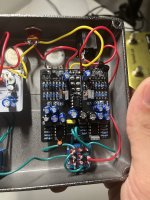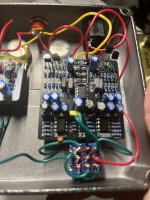artemis_effects
New member
Hey all,
I’m having an issue with the Hyped Fuzz where Fuzz I and II both fail to sustain below 3-4 o’clock on the Gain pot, fizzling out dying battery style. I’ve built two previously, one of which had this same problem. I replaced one of the transistors and it worked perfectly, so that’s exactly what I’ve done here, but to no avail. I’ve proceeded to replace all the transistors twice now with no noticeable difference. I do own a multimeter but I am not sure how to test transistors with it. There are a lot of settings on the MM and I am kind of an idiot.
Context: A few of my resistor values are off, none by that much, but i think I do have a 27k in place of a 22k. I also am using all TL072s for ICs, which worked on both of my previous FZ-2 builds. This current build is housed with a Gray Ash clone and the wiring is correct (as far as I can tell). Everything does ‘work’ but both fuzz settings are barely registering my picking below very high Gain settings. I accidentally snipped the left leg of the Q3 transistor and there was a huge improvement in sustain, but the Gain knob was pretty much full bore until its turned fully CCw so I don’t really want to settle for that. Additionally, the boost setting has some slight bleed, like a very quiet distortion.
If anyone could provide advice, I’d be tremendously appreciative. I’m sure if anyone does respond they’ll tell me to get a reading on the meter, which I swear I’ll learn how to use, but if this seems non-transistor related, I could use the help!!!
I’m having an issue with the Hyped Fuzz where Fuzz I and II both fail to sustain below 3-4 o’clock on the Gain pot, fizzling out dying battery style. I’ve built two previously, one of which had this same problem. I replaced one of the transistors and it worked perfectly, so that’s exactly what I’ve done here, but to no avail. I’ve proceeded to replace all the transistors twice now with no noticeable difference. I do own a multimeter but I am not sure how to test transistors with it. There are a lot of settings on the MM and I am kind of an idiot.
Context: A few of my resistor values are off, none by that much, but i think I do have a 27k in place of a 22k. I also am using all TL072s for ICs, which worked on both of my previous FZ-2 builds. This current build is housed with a Gray Ash clone and the wiring is correct (as far as I can tell). Everything does ‘work’ but both fuzz settings are barely registering my picking below very high Gain settings. I accidentally snipped the left leg of the Q3 transistor and there was a huge improvement in sustain, but the Gain knob was pretty much full bore until its turned fully CCw so I don’t really want to settle for that. Additionally, the boost setting has some slight bleed, like a very quiet distortion.
If anyone could provide advice, I’d be tremendously appreciative. I’m sure if anyone does respond they’ll tell me to get a reading on the meter, which I swear I’ll learn how to use, but if this seems non-transistor related, I could use the help!!!



